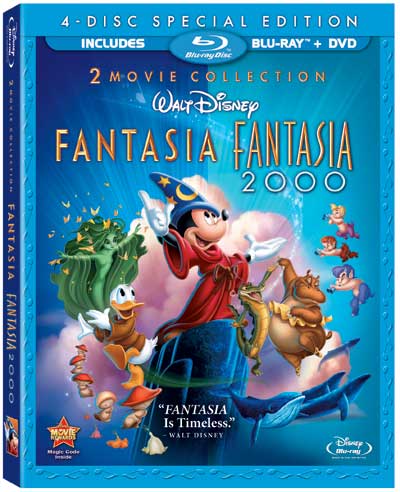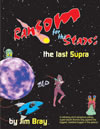 |
||

Fantasia, and Fantasia 2000 on Blu-ray discWalt Disney's fantasy, if you can call it that, was Fantasia, in which his animators took famous classical music pieces and created animated "moving pictures" inspired by the music. It was a bold move, and it didn't pay off initially, but Fantasia has over the decades received the critical claim it deserved right off the bat. And decades later - six decades, to be exact - Walt Disney's reborn and reinvigorated animation division revisited the concept, using today's state-of-the-art techniques to create a musical journey even more compelling than the original. It's just too bad that Fantasia 2000, at 75 minutes, is so short that it barely whets the appetite for what they could have accomplished. What better way to watch these musical classics than on Blu-ray, with its state-of-the-art picture and sound? True to form, the folk at Disney have given us a sparkling transfer for both films, though - and this shouldn't be surprising - the newer Fantasia 2000 is appreciably better from a technical standpoint. But that doesn't mean the original is a slouch. In fact, this is once again the best version of the film to appear on video, with bright colors and a very sharp and detailed image. It's just that the newer version is better - stunningly good, in fact - making use of modern CG techniques and an expanded color palate that translates beautifully to the digital high definition disc. But let's talk about the movies themselves, presented here in a four disc set that includes Blu-ray and DVD discs of both movies, with plenty of supplementary materials on the BD discs. Fantasia, which came out in 1940, is a marvelous experience, though we thought it just a tad heavy - in that, we'd have loved to see music from such composers as Strauss included as well (imagine Disney animators let loose on "Tales from the Vienna Woods" or "Voices of Spring", for example), to lighten up the proceedings. But that's about our only wish from this (other than picture and sound that can match the companion piece's). Think of it more as a concert with incredible visuals, with a narrator and conductor appearing on screen between numbers to help guide the audience through the proceedings. It starts simply enough, with simple animation of musical instruments (or parts of), building with the music until, in subsequent numbers, we're treated to balletic animals, relentless brooms, overwhelming beasts and more. It's a beautiful production that deserves its spot in animation and musical history. According to Disney's promotional materials, Fantasia earned two special Oscars at the 14th Annual Academy Awards presentation the year after its release. The first was given to Walt Disney and associates for their outstanding contribution to the advancement of the use of sound in motion pictures (Disney, ever the innovator, had created the first commercial film to be released in multi-channel sound - in this case called "Fantasound"). The second was given to conductor Leopold Stokowski and his associates "for…unique achievement in the creation of a new form of visualized music…thereby widening the scope of the motion picture as entertainment and as an art form." That's how innovative Fantasia was in its day. We can see why its public acceptance may have been less than Walt Disney had hoped for. After all, people were used to "Snow White" and the same year he released Fantasia Disney also released "Pinocchio", two films that were very different than the avant-garde "concert film". It eventually found its audience, however, and in 1990, it was selected for preservation in the United States National Film Registry by the Library of Congress as being "culturally, historically, or aesthetically significant." In some ways, Fantasia 2000 is even better. It uses the same basic concept, but rather than having a single narrator (Deems Taylor hosted Fantasia), they drag out a bunch of pop culture icons to introduce pieces in their own unique ways - people such as Steve Martin, Whoopie Goldberg, Bette Midler, Quincy Jones, and Penn and Teller. Their intros are okay, but they get in the way. Our other complaint about Fantasia 2000, as mentioned, is that it's too short - and it's even shorter when you take into consideration that they've repeated "The Sorcerer's Apprentice" from the first movie. Yet, on the upside, they've included Gershwin's "Rhapsody in Blue" and Elgar's "Pomp and Circumstance" the latter of which is played against the background of the story of Noah - and it not only works very well it lets Disney cast Donald and Daisy Duck much as Walt Disney did with Mickey Mouse in the original. Ottorino Respighi's "Pines of Rome" features flying whales, and that might seem pretty silly but the point of the piece appears to be showcasing the grace of the huge animals and the animators have pulled it off perfectly. It's stunning. Likewise, they've made "Rhapsody in Blue" into a kind of urban slice of life (lives, actually) and though we initially didn't think much of it by the time it was finished we were hooked. Saint-Saëns's "The Carnival of the Animals" is a cute and funny piece of fluff featuring a yo-yo-wielding flamingo (yeah, it sounds dumb, but watch it! It's actually a pretty neat piece of comedy relief.) Viewed back to back makes for a long evening in the home theater, though no longer than something like "Ben-Hur", but it's a wonderful experience and a great way to introduce the family to some quality classical music. Individually, we like Fantasia 2000 best, though as mentioned we found the modern narrators intrusive and "Sorcerer's Apprentice", with its dated audio and video, sticks out like a sore thumb in it. The video and sound is as good as you could expect and once again Fantasia 2000 wins the battle - it is particularly gorgeous visually and aurally (crank up the sound!). We'd recommend watching the films in order, not only for the progression of tunes but so you can reward the kids' patience with the heavier Fantasia with the sumptuous home theater feast of Fantasia 2000. Disney has also included the Oscar-nominated short film "Destino", a seven minute film collaboration between Walt Disney and Salvador Dali begun in 1946, but never finished until Roy E. Disney and the studio's contemporary animators finished it as a tribute to Walt Disney's vision. They've also included the all-new feature length documentary "Dali & Disney: A Date With And that's just the first salvo of extra material. Here's a full listing of all the extra stuff on the Blu-rays, according to the Disney folk: • New Audio Commentary with Disney historian Brian Sibley Fantasia features its original aspect ratio of 1.33:1, while Fantasia 2000 is at its original widescreen ratio of 1.78:1 If you love music and you love animation, this package is really a "must have". Jim Bray's columns are available from the TechnoFile Syndicate. | ||

